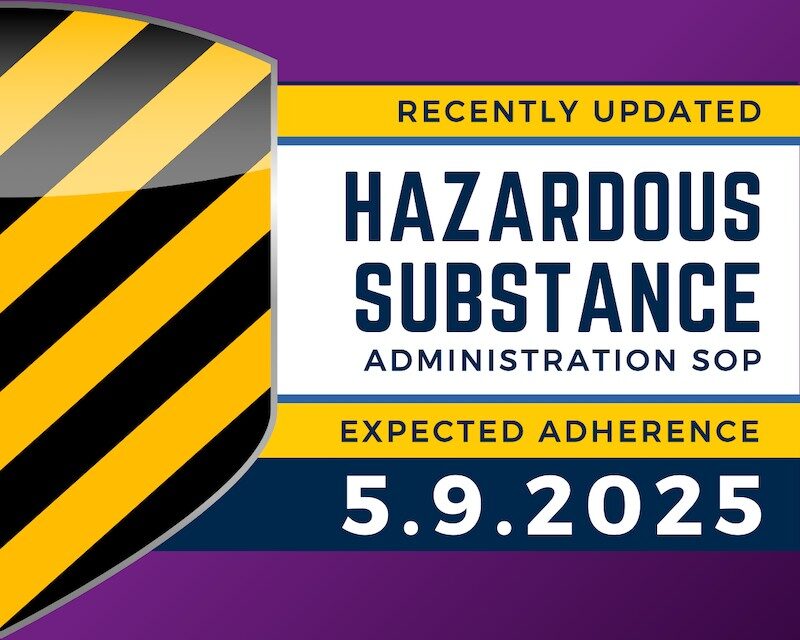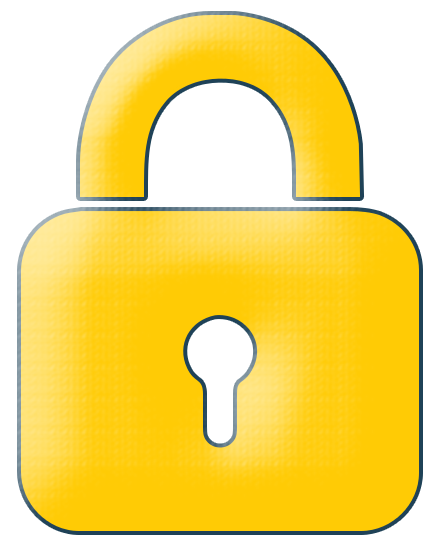
To ensure continued compliance with best practice standards in animal care and use and laboratory safety, the Animals Administered a Hazardous Substance Requiring Containment Standard Operating Procedure (SOP) was recently updated.
Updates and process changes are applicable to ANY individual who may perform procedures that involve the handling of animals and/or animal equipment contaminated with hazardous substances.
As such, every individual – including research personnel and ULAM staff – who performs these tasks as part of their job responsibilities must read the updated SOP in its entirety to assure that they are familiar with, and adhere to, the required procedures.
All personnel are expected to follow the new and revised procedures outlined in the updated SOP by Friday, May 9, 2025.
Key changes are summarized below and will be highlighted on posters in affected animal care facilities in the coming weeks. Training classes offered by the ULAM Training Core will also be adjusted to reflect all process/procedural changes.
Summary of Changes
Procedure/Area of Interest
New/Revised Procedure Summary
“Biological” and “Infectious” Definitions
Previously, these terms were used interchangeably throughout the SOP. The document and all associated appendices have been updated to reflect the correct term, “biological.”
This change aligns with the terminology used in the Biosafety in Microbiological and Biomedical Laboratories, an advisory document published by the Centers for Disease Control and the National Institutes of Health, which outlines best practices for the safe conduct of work in biomedical and clinical laboratories.
Additional Considerations for ABSL-2 Enhanced Studies
Some enhanced ABSL-2 studies involving rodents and certain respiratory pathogens require additional housing and safety precautions.
A new appendix (Appendix B) has been added to outline these requirements, including how research staff should request appropriate housing space and how ULAM husbandry staff will process these unique requests.
New Reference Documents Added to the Containment Room Binder
To make information more accessible, four existing SOPs (see list below) will be added to the standard list of documents provided in each Containment Room Binder.
The following SOPs ![]() will be added by ULAM staff for all personnel to reference as needed:
will be added by ULAM staff for all personnel to reference as needed:
Binder for Biological and Chemical Cage Labels
Each containment housing room/procedure space will now include a separate binder (see Appendix H) labeled “Non-Dissolvable Hazardous Cage Stickers” where required orange and green labels for cages and carcasses can be found.
ULAM staff will be responsible for restocking these supplies. Research personnel are required to use the labels in the binder and follow all required labeling processes as outlined by the SOP.
See the Standard Husbandry and Substance Administration Practices section and Appendix L – Labeling Cages & Bottles for more information.
Solutions Used to Sanitize Biological Safety Cabinets (BSCs)
The revised SOP clarifies what solutions are acceptable for proper sanitization of BSCs prior to cage manipulation. A bleach/water solution that has been previously prepared in a spray bottle can now be reused.
Prior to this change, only a FRESH bleach/water solution could be used.
“Naive” Replaced with “Non-Hazardous”
“Naive,” a term previously used to describe cages/animals that have NOT been administered a hazardous substance, has been replaced with the term “Non-Hazardous.”
Yellow acetates indicating “Non-Hazardous” should be PLACED when:
- The hazardous substance is no longer present in the animals (note: this is a new process),
- New arrival cages are unpacked directly into containment housing (ULAM staff), and/or
- A cage has been transferred into containment housing from another room and NO hazardous substances have been administered (research personnel).
Yellow “Non-Hazardous” acetates should be REMOVED when:
- Animals have been administered a hazardous substance and/or
- Animals have been removed from the room.
ULAM staff are responsible for stocking rooms with yellow “Non-Hazardous” acetates, and research personnel are responsible for labeling all “Non-Hazardous” cages in accordance with the procedures outlined by the SOP.
Sanitize Cage Cards/Barcodes PRIOR TO Deactivation
All cage cards/barcodes must be wiped down with a SaniWipe PRIOR TO leaving the containment housing room and BEFORE being placed in the central collection box for deactivation.
Simplified System for Cage Change Order
Previously, a 1-4 Tier System was used to delineate proper cage change order. This system has been simplified to “Non-Hazardous” and “Hazardous” cages.
The cage change order for each housing room and individual cubicle is now as follows:
- Change cages acetated “Non-Hazardous” first
- Change all “Hazardous” cages after “Non-Hazardous” cages
Clarified What Equipment Must Be Sanitized BEFORE Leaving the Room
The SOP now includes examples of the specific types of devices/equipment that must be sanitized BEFORE they can be removed from the containment housing room.
Examples include restrainers, glassware, instruments, anesthesia machines, or any other devices/non-caging items used to manipulate and/or handle animals administered a hazardous substance.
Fiber Drum Lid Replacement
The fiber drums used for collecting hazardous waste will now be covered with a plastic reusable lid until they are full and ready for pick up by Hazmat.
- ULAM Staff – are responsible for providing the new lids, arranging HazMat pick up, and wiping down the lids as needed.
- Research Personnel – are responsible for discarding hazardous waste in the appropriate (fiber drum) receptacle and replacing the plastic reusable lid when they are done.
Requesting Secondary Transport Containers
Extra precautions must be taken when transporting animals administered hazardous substances to/from containment housing, including the use of a secondary transport container.
Secondary transport containers will no longer be automatically stocked in containment housing rooms. Containers are available upon request through ULAM husbandry staff.
To ensure availability, Study Teams are strongly encouraged to request materials at least 72 hours in advance of when the equipment is needed.
![]() Links marked with a lock icon can only be accessed using valid U-M login credentials.
Links marked with a lock icon can only be accessed using valid U-M login credentials.
Procedure/Area of Interest
New/Revised Procedure Summary
Location/Placement of Waste Labels on the Fiber Drum
Previously, waste labels could be placed anywhere on the fiber drum used to collect hazardous waste.
Waste labels must now be placed ON THE SIDE of the fiber drum to accommodate the new plastic reusable lids.
Sharps Container Replacement
A Michigan state law passed in Fall 2024 now allows for sharps containers to be used either until they are ¾ full or 18 months from the date sharps were first added to the container.
Questions?
- Specific questions about any of the processes outlined in the Animals Administered a Hazardous Substance Requiring Containment SOP should be directed to your facility’s ULAM Husbandry Supervisor.

- To request supplemental training on the proper procedures for handling animals administered a hazardous substance, please contact the ULAM Training Core at [email protected] or (734) 763-8039.
- General questions pertaining to laboratory safety in animal care facilities should be directed to the department of Environment, Health & Safety (EHS) at [email protected] or (734) 647-1143.
![]() Links marked with a lock icon can only be accessed using valid U-M login credentials.
Links marked with a lock icon can only be accessed using valid U-M login credentials.